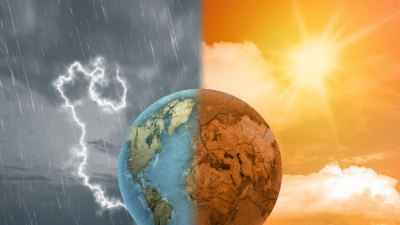How Ice Crystals Create Halos Around the Moon
Explore the fascinating phenomenon of moon halos caused by ice crystals in the atmosphere.

Image by rawpixel-com on Freepik
Have you ever gazed up at the night sky and noticed a shimmering halo encircling the moon? This remarkable atmospheric phenomenon, known as a moon halo, captivates many stargazers and provides a spectacular sight. Understanding how moon halos form involves delving into the interaction between ice crystals in the atmosphere and moonlight. In this article, we will explore the science behind moon halos, the types of halos that exist, and the atmospheric conditions required for their formation.
Understanding Moon Halos
A moon halo is a circular ring of light that appears around the moon, caused by the refraction, reflection, and dispersion of moonlight through ice crystals suspended in the atmosphere. The most common form of a moon halo occurs when the moon is shining brightly and the sky is clear. However, this phenomenon can also appear when the atmosphere contains thin cirrus clouds composed of ice crystals. These clouds form at high altitudes, typically above 20,000 feet, where the temperature is low enough for ice formation.
The Science of Ice Crystals
To understand how moon halos develop, it's essential to know about the ice crystals responsible for their creation. Ice crystals in the atmosphere come in various shapes, most commonly as hexagonal plates or columns. The orientation of these crystals is critical, as they affect how they bend or refract light. When moonlight encounters these ice crystals, it can be refracted at a specific angle, typically 22 degrees, forming the familiar halo around the moon.
Refraction and Reflection
Refraction occurs when light passes through a medium with a different density, changing the light's direction. For moon halos, this means that as moonlight enters the ice crystals, it bends at specific angles. This bending creates a ring of light around the moon. Reflection also plays a role in halo creation; some light is reflected off the surfaces of the ice crystals, enhancing the halo's brightness. Together, these processes result in the stunning visual effect of the moon halo.
Types of Moon Halos
There are various types of moon halos, each depending on the conditions present in the atmosphere and the arrangement of ice crystals. The most common type is the 22-degree halo, which appears as a bright white ring surrounding the moon at approximately 22 degrees from its center. This halo is so prevalent that many people may not realize there are additional varieties. Some of the other types include the 46-degree halo, which is larger and often dimmer, and various parhelia, or sun dogs, that can also appear when the sun is low on the horizon.
Weather Conditions Favoring Moon Halos
For a moon halo to form, certain atmospheric conditions must be met. First, the moon needs to be bright—typically, this means a full moon or nearly full moon phase. Next, the presence of cirrus clouds made up of ice crystals is crucial. When thin ice clouds cover the sky, they allow moonlight to pass through, leading to the refraction and reflection essential for halo formation. Finally, cold weather often accompanies these high-altitude clouds, contributing to the ice crystal formation.
The Beauty of Moon Halos
Beyond their scientific explanation, moon halos are breathtaking natural spectacles that leave observers in awe. They often appear as ethereal rings of light, creating an almost mystical atmosphere. Photographers and sky enthusiasts revel in capturing the beauty of moon halos against picturesque night skies, often adding to the allure of outdoor activities at night. In many cultures, moon halos are viewed as omens or signs, adding a layer of intrigue to their existence.
Cultural Significance of Moon Halos
Throughout history, people have woven various myths and legends around moon halos. In some cultures, a halo around the moon is seen as a portent of changes in the weather, indicating that precipitation may be on the way. In others, moon halos are linked to spiritual or mystical beliefs. The striking visual of a halo can stir feelings of wonder and connection with the natural world, reminding us of the beauty that exists above us.
Observing Moon Halos
If you're intrigued by moon halos and want to observe them for yourself, a few tips can enhance your experience. First and foremost, choose a clear night with little light pollution. Areas away from city lights provide the best opportunities for sky observation. Additionally, knowing the phases of the moon can help you plan your viewing session, as halos are most pronounced around a full moon. Bring a camera to capture this enchanting display, and perhaps consider learning about other celestial phenomena that can occur alongside halos.
Moon halos are a captivating intersection of science and beauty, created through the interaction of ice crystals in the upper atmosphere and moonlight. The elegant rings that encircle the moon remind us of the extraordinary processes occurring in our atmosphere, often unnoticed. Whether you are an astronomer, a photographer, or someone simply admiring the night sky, moon halos are an awe-inspiring occurrence that beckons exploration and appreciation. So next time the moon is bright, take a moment to look up and witness the beauty of moon halos.











